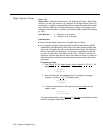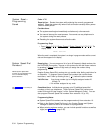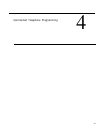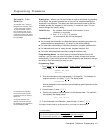
Table 3-1 Special Dialing Functions
Function
Button Display
Description and Example
Pause
[
Hold
]
P
Inserts a 1.5-second pause in the dialing sequence to wait
for a response, such as a dial tone or computer voice mes-
sage.
Example:
To call an answering machine at 555-0529, wait
4.5 seconds, then dial 321 to retrieve messages, enter [ 5
]
[ 5 ] [ 5 ] [ 0 ] [5 ] [ 2 ] [ 9 ] [ Hold ] [ Hold ] [ 3 ] [ 2 ] [ 1 ].
Recall
[ Spkr ]
R
Sends a timed switchhook flash needed to alert the system
on the other end (such as a PBX or Centrex), and to use
some local telephone company custom calling features
(such as Call Waiting). Use Recall only as the first entry in
a speed dial number.
Example:
To use a favorite Centrex feature, you have to
send a timed switchhook flash and then dial 388. Enter
[ Spkr ] [ 3 ] [ 8 ][ 8 ].
Stop
[ Mic ]
S
Stops the dialing sequence so the user can enter addi-
tional digits, such as a credit card number or password.
Press [ Feature ] and the 2-digit speed dial code to continue.
Note:
Since PARTNER 6-button phones have no
[
Mic
]
but-
ton, the Stop dialing function is not available on those
phones.
Example:
Your local bank-by-phone service requires you
to enter a password before the account number. To pro-
gram a marked speed dial number to call the bank at 555-
7898, include a stop for manually entering the password,
and continue with the bank account number (679 556 88),
enter [ * ] [ 5 ] [ 5 ] [ 5 ] [ 7 ] [ 8 ] [ 9 ] [ 8 ] [ Mic ] [ [ 6 ] [ 7 ] [ 9 ] [ 5 ] [ 5 ] [ 6 ]
[ 8 ] [ 8 ] . Marking the phone number prevents the account
number from being displayed when users dial it.
Touch-Tone
[ Transfer ]
T
Sends touch tones over a rotary line to electronic equip-
Enable
ment such as answering machines and bank computers.
Example: Your system is connected to rotary lines but
you want to call an answering machine at 555-3454 to
retrieve messages. Since the answering machine requires
touch tones, enter [ 5
] [ 5 ] [ 5 ] [ 3 ] [ 4 ] [ Transfer ]. All
digits pressed during the rest of the call are sent as touch
tones.
3-36 System Programming


















